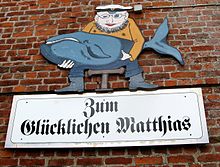Matthias Petersen
Matthias Petersen (* December 24, 1632 in Oldsum ; † September 16, 1706 ; also Matz Peters ) was a North Frisian captain and whaler from Oldsum on the North Frisian island of Föhr .
With epithets as "Fortunately Matthias", "Matthias the lucky" or "Mathis der Happy" is known, gained Matthias Petersen fame by killed 373 whales within five decades and came to great prosperity, which is why he, like his stone grave slab on the cemetery of the church of St. Laurentii in Süderende on Föhr, "with the consent of all, assumed the name 'The Happy'".
Life
Matthias Petersen was born on December 24, 1632 as the son of Peter Johnen on the island of Föhr. He received his nautical training at the navigation school which the pastor at St. Laurentii in Süderende Richardus Petri had set up. At the age of twenty, Petersen was given command of a whaling ship and he retained the rank of commander for the next 50 years. During 19 successful fishing trips as a commander, he earned a high income. Petersen's success was due in large part to the fact that he participated in his time still on the so-called "Baienfischerei" in which the whalers large amounts of whales in the bays (bays) within a short period of Spitsbergen could impose. When the local stocks were exhausted, the activity of the hunters increasingly shifted to the open sea, which was less profitable and also more dangerous. But it was probably also his long experience as a seafarer that helped Petersen.
In 1677 he and his brother donated two large brass chandeliers to the parish of St. Laurentii , which are still in use in the church today.
In 1701, at the beginning of the War of the Spanish Succession , Petersen's eldest son Matz, also a commander, was kidnapped by a French pirate to St. Malo , but he was ransomed. In 1702 Petersen himself was attacked by the French on his last trip and had to buy himself and his team out for a ransom of 8,000 Reichstalers . In the same year, his two sons, Ock and John, also died fighting French pirates.
Matthias Petersen bequeathed 100 gold thalers to the parish in his will, which were not paid out by the heirs. After years of efforts by the parish to receive the amount from the heirs, the grave of Matthias, who had been buried with honors in the church 14 years earlier, was relocated to the cemetery, where the stone can still be seen today.
Children and descendants
Matthias Petersen was married to Inge Matthiessen (1641–1727) since 1663, with whom he had twelve children, four of whom died as small children. Their children received an education from a private tutor so that his sons Clement and Peter Matthiesen could study. Clement became a preacher at Schwesing and it is believed that it was he who designed the Latin text for the inscription on his father's grave slab.
Peter Matthiessen was after studying at the Husum Latin School and the University of Jena Landvogt both Osterland Föhr and Sylt and court bailiff of Wyk on Foehr. His son Peter was also bailiff of Osterland Föhr and also Birkvogt of Westerharde Föhr , to which Amrum also belonged. His college friend, Count Johann Friedrich Struensee , appointed him mayor of Copenhagen in 1771 . However, after Struensee was executed for high treason, Peter Matthiesen Junior became director of the “Trade and Fisheries Institute” of Altona , which at that time belonged to the entire Danish state . From there he helped many seafarers from Föhr to get jobs in the Greenland shipping industry.
The sons Matz (Matthias) (* 1665), Ocke (* 1674) and John (Johann) (* 1681) became seafarers and perished in 1701/1702. Jung-Ocke or Otto Matthiesen (1679–1764) settled down as a merchant in Altona after a successful time as a commander . The only surviving daughter married a Nieblumer commander. Her great-grandson Jens Jacob Eschels wrote the oldest surviving authentic German captain's autobiography.
The American author and environmentalist Peter Matthiessen (1927-2014) was a descendant of Matthias Petersen, according to his father's family chronicle from 1811. According to this chronicle, Matthiessen emerged from the line of the Petersen son Otto (see above). In the late 1980s he visited the island of Föhr for the first time on the trail of his ancestors and reported on it in an autobiographical essay.
literature
- Uwe Steffen : The most successful whaler of the North Frisians - Matthias the Happy and his time. North Frisian CVs 8. Verlag Nordfriisk Instituut , Bräist / Bredstedt 2009, ISBN 978-3-88007-359-3 .
- Peter Matthiessen : The search for the happy Matthias - An American on the trail of his ancestors, in: Merian - Sylt • Amrum • Föhr. Edition May 1989, 42nd year, Vol. 5, pp. 114-127. Hoffmann and Campe Verlag, Hamburg 1989
Web link
- Gravestone on the side of the parish of St. Laurentii
Individual evidence
- ↑ Berend H. Feddersen: The year of the whale and seal hunters . In: Klaus Lengsfeld (Hrsg.): The historical whaling of the North Frisians . tape 1 . Husum Druck- und Verlagsgesellschaft, Husum 1991, ISBN 3-88042-578-7 .
- ↑ Uwe Zacchi: People from Föhr. Life paths from three centuries . Boyens & Co., Heide 1986, ISBN 3-8042-0359-0 , p. 12 .
- ↑ Peter Matthiessen : The search for the happy Matthias - An American on the trail of his ancestors, in: Merian - Sylt • Amrum • Föhr, 1989
| personal data | |
|---|---|
| SURNAME | Petersen, Matthias |
| ALTERNATIVE NAMES | Peters, Matz |
| BRIEF DESCRIPTION | German captain and whaler |
| DATE OF BIRTH | December 24, 1632 |
| PLACE OF BIRTH | Oldsum |
| DATE OF DEATH | September 16, 1706 |

